originally posted at https://canmom.tumblr.com/post/632065...
welcome, fwiends :3c i have so many cutesy wootsy animamations to put into your wittle eyebwalls tonwight
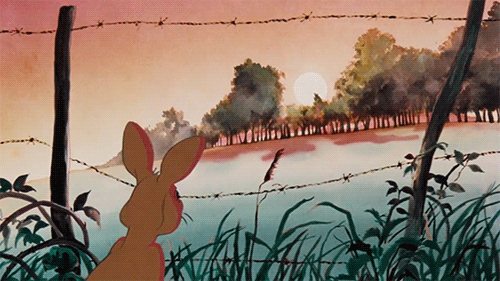
As alluded to at a shockingly late hour last night (don’t ask), tonight’s Animation Night is about animals.
Now, I need to be a little more specific than that, because animators love portraying anthropomorphic animals! From the very beginning of the medium, a huge proportion of animated shorts and films have focused on anthro animal characters in basically human roles, like Micky Mouse (Disney) and Bugs Bunny (Warner Bros.), though all too often with an uncomfortable dose of minstrel acts in their portrayals. And among the earliest animated feature films, we have the French stop-motion Tale of the Fox (Roman de Renard). This has continued well up into the present…
But that’s not our focus tonight! Nor is it more specifically furry-aesthetic films, like Disney’s Robin Hood and Zootopia, or furry anime such as Mamoru Hosoda’s Boy and the Beast, Trigger’s Brand New Animal or Orange’s Beastars. (Of these, we might cover a bit of BNA at some point. Maybe.)
For the vast majority of these works, the focus is on, essentially, human characters with animal-like traits as a visual metaphor. Animal behaviours like predation, or human hunting of animals, may provide plot impetus; but it’s mostly in its own world of ‘cartoon’ logic, or naked metaphors for human themes. However, not all animated films have taken this approach…
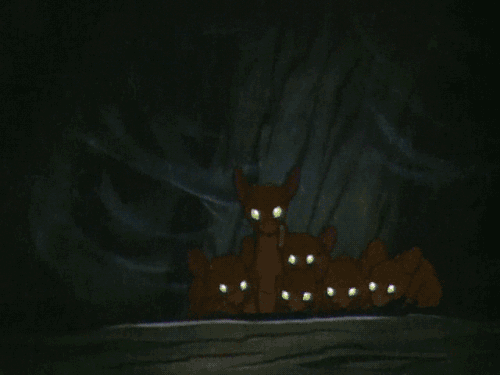
Tonight, the focus is on animation which attempts to portray animals from a slightly different angle: animals living in nature. Not necessarily realistic animals, but much more so than most animation.
The appeal of animating animals in this way is clear, for filmmakers who wish to deal with the relations of humans and animals - especially when the intent of the film is to oppose human cruelty against animals, it would make little sense to inflict such cruelty in the making of the film. Moreover, through animation, animals can be portrayed as having human-relatable emotions, while getting real life animals to act out a role in a film is, to put it mildly, not an easy task.
Of course, the flagship in this realm is Watership Down. This story began life as a weighty tome of a debut novel by Richard Adams, written in 1972. Drawing inspiration from the large populations of rabbits living on a real-life hill in Hampshire, Watership Down attempts to speculatively imagine the religion and anthropology (lapinology?) of rabbit society, living a precarious existence of a prey animal always on the edge of death. Its characters draw heavily on Adams’s experiences fighting in WWII, which might explain a little of the tone.
Naturally this makes it highly applicable as metaphor, though it’s not a direct allegory. As this video relates, it struggled to find publication, eventually landing with Rex Collings, otherwise a specialist in translated African literature. The risk paid off, and the book was rapidly deemed a classic of children’s literature. One of the people it struck a chord with was filmmaker Martin Rosen.
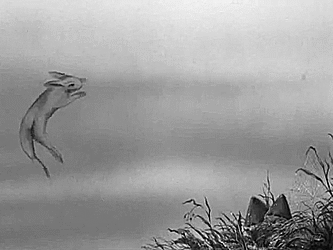
Watership Down would be one of the few times (alongside the works of Raymond Briggs) the UK has ever produced a serious traditionally animated film. The origins of the film are marked by tragedy: Martin Rosen, a huge fan of the book, got lucky in finding funding and support from a highly connected bank-owner called Lord Poole. He employed animator John Hubley to direct the film, who helped Rosen learn about the craft… but Rosen ended up firing Hubley over side work he was doing for ABC. Before they might ever reconcile, Hubley died a few weeks later in heart surgery, leaving Rosen - who had never before worked in animation, but was determined to make the film - to direct the film himself.
Even after Hubley’s death, the film faced many more hurdles. The composer, Malcolm Williamson, fell into depression trying to work on the film score alongside a Silver Jubilee symphony for the royal family (because this country is already a cartoon!) and completed only six minutes. Luckily, the film’s editor Terry Rawlings - who would later become well known for his work on films like Blade Runner and Alien! - had another connection: Angela Morley, a wildly talented trans composer whose reputation had basically evaporated since all her work was under her dead name.

Morley was hesitant to commit to such a big body of work, but they won her around and managed to create the whole thing in two weeks flat, except for the film’s one major song Bright Eyes by Art Garfunkel. (Despite attempts to snub Morley from the soundtrack, Rosen fought her corner, and the film helped her reestablish herself and move to America - notably, she worked with John Williams on a large number of Spielberg films.)
So despite all the struggles it faced getting made, the result is something remarkable - animation with the cinematographic eye of live film, dealing heavily with the theme of death, in a vision of British countryside that is cold and brutal and dangerous. It features gorgeous animations of lifelike rabbits moving with weight and grace, closely studied on real life, with only minimal concessions to adjusting the designs to express human-readable emotions. I don’t know of any nature animation quite like it, except for Rosen’s second animated film, the much less-popular Plague Dogs.
So. That’s one film, and one I’m very excited to finally see. Naturally, content warning for a lot of terror and animal death.
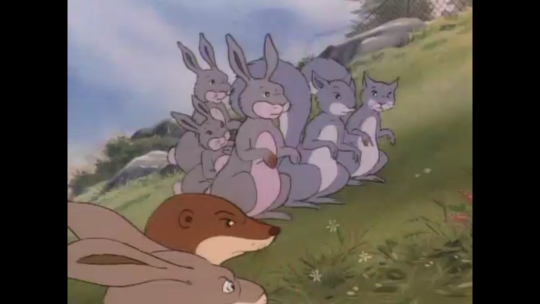
As it turns out, Watership Down was not the only time British traditional animation portrayed animals in unexpectedly dark, violent ways. That category also applies to a joint UK-French project funded by the EBU, called The Animals of Farthing Wood.
At first glance, Farthing Wood might seem like standard kids-tv fare: animals attempting to flee deforestation for housing development and reach the safety of a nature reserve. Although the character designs lean towards the naturalistic end, it’s largely limited animation without the budget to get a lot of iteration or appeal. But… for whatever reason, the creators of Farthing Wood decided to go all in on scenes of all-too-realistic animal death. From how its been described to me, the series takes on elements of outright psychological horror. There are scenes of animals being impaled by a shrike, freezing in terror to die on the motorway, and even a grieving widow pheasant unable to flee the hunter who killed her partner.
So naturally I thought “that sounds like my jam!”, and then sat there for a minute wondering what it says about me.
We’re going to watch one episode of Farthing Wood: Season 1, Episode 10, featuring the motorway scene.

Now, the proboscid even-toed ungulate in the room when it comes to nature animation is of course Bambi (1942). One of the animated films produced in Walt Disney’s lifetime, Bambi built on the early woodland-creature animation in Disney’s Snow White, telling a kind of parable about the life of a small deer growing into a big deer, while doing all the deer things you’d expect. Unlike Snow White, whose own animators dismissed its portrayal of deer as ‘like sacks of flour’, Bambi’s deer are built on close study of actual animals.
And the result… well, it’s certainly very ideological. The major thrust of the film is against human intrusion into ‘unspoiled’ nature; thus the villains of this film are human hunters, whose gunfire interrupts the idyll. In portraying this idyll, they lean heavily on a sort of fantasy image of noble animal heterosexuality. The female deer are hyperfeminine with soft curves and long eyelashes, the adult male deer tall and stoic and masculine; the children deer are aggressively cute and playful. Deer life, it turns out, is just a mirror of the 1950s ideal of the nuclear family. Fancy that.
The film, based on a rather dark nature novel, went through many iterations in the script: at one point, they put weeks into a scene where Bambi accidentally destroys an ant civilisation; at another point, Walt was keen to have a scene where a hunter burns himself to death. Sadly, such enticingly weird subject matter was deemed too heavy for children - not that it let the film escape criticism for its supposed abandonment of fantasy.
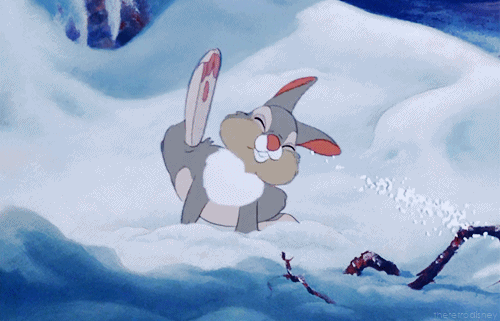
Among the adjustments to adapt Bambi is accompanied through the story by a cute rabbit called Thumper who, like Bambi, has big anime eyes and an improbably upright posture. Thumper, Bambi and the like are all characters in the system of Disney character animation: they bounce and squash and stretch and show a lot of lively body language.
To elaborate on that a bit, lemme talk a bit about the differences in animation organisation between American and Japan. For anime, the usual rule is to divide up a work into specific scenes, or ‘cuts’, which can be assigned to different key animators. A key animator who specialises in flashy action may get a fight scene, while another less experienced animator might be assigned a simple talking heads scene. The animator’s emphasis is on cinematography, effects and editing as much as the ‘acting’, with less emphasis on distinguishing a character by body language alone. Also, budget constraints limit the use of Disney-style ‘full’ animation, encouraging animators to use dramatically held poses and accentuate them with effects and camera movement.
In the Disney system, by contrast, each animator is seen as akin to an actor, and given one or a few characters to animate for pretty much the entire movie (for example, Milt Kahl was often assigned ‘straight’ characters like princes, whose more restrained motion was harder to do well). The pinnacle of animation was seen as bringing out the specific, unique mannerisms of a character. It would be unthinkable for a character animator to also do effects animation, like water. It was not always this clear-cut, but that was the philosophy.
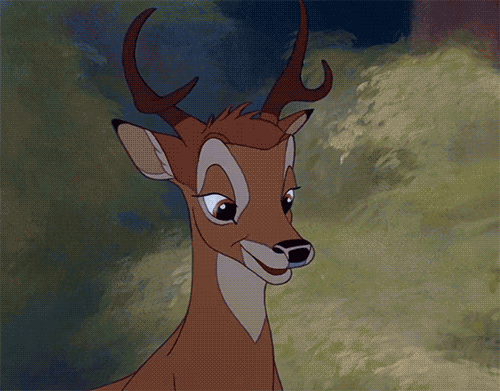
But the animators weren’t the only ones who made Bambi shine: a lot of the film’s best qualites are the gorgeous background paintings of forest in a watercolour style, which play a part in the cinematography, using detail to draw the eye to the centre where the action is. These were the idea of the film’s art director Tyrus Wong; the story goes that veteran Disney artist Jake Day was trying to paint forests from life, but the results were far too busy and confusing; he saw Wong’s Song dynasty-inspired paintings and was so impressed that he gave Wong the position. Wong would go on to have a long career in film, though sadly it doesn’t look like he’d do much more in animation.
So! For the sake of this history post, I had to discuss Bambi, but honestly… I can’t get all that excited to watch it in full. Instead, though the movie is only an hour long, I’m leaning towards pulling out the two most interesting scenes: the bit where Bambi’s mother dies, and the bit where Bambi fights another deer for his deer love interest, which is rendered in stark chiaroscuro with backlit deer to a clashing orchestral soundtrack. It’s still quite 40s - early Disney’s orchestration never really worked for me - but it’s definitely a break from the twee heterosexualisms of the rest of the film.
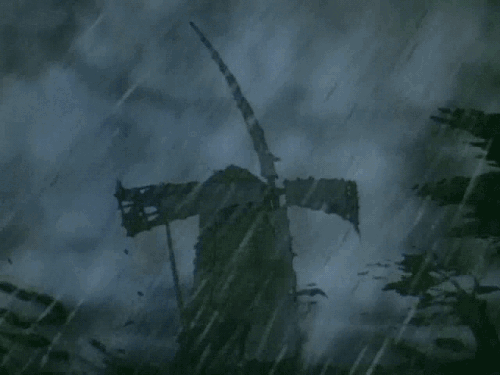
Also on the Disney front, we have another, even earlier piece of Disney animal animation: the Silly Symphonies short The Old Mill, from a few years prior to Bambi in 1937. (Hats off to this Vulture history of influential animated sequences for alerting me to this classic piece of animation). This short dates back to a time when the multiplane camera was a new invention, and features probably Disney’s most naturalistic depictions of animals, as a storm shakes the rafters of an old windmill, threatening the animals living inside.
So if not Bambi, then what of our second feature? We’re going to break from the theme a bit to introduce a certain Don Bluth.
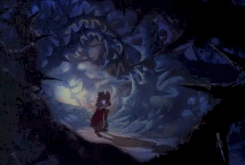
I don’t have time right now to get all into his career, but Don Bluth is an American director specialising in animated films, who is generally known for a two things: for making a lot of elaborate fantasy adventure films that can be fairly compared with Disney in terms of character animation… and for being one horny dude whose animation often leans to the extremely fetish-oriented, especially when it gets into transformation sequence territory.
The Secret of NIMH, Don Bluth’s debut film starts out as something not too far afield from the other films on this list: a small community of field mice are threatened by the activities of humans, in this case a farmer whose plough threatens to destroy their homes.
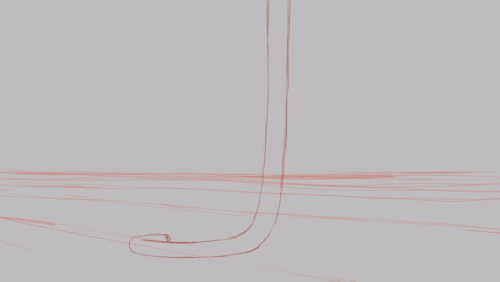
Only, from there, things go in a very fantasy direction. Hoping for a way to escape their predicament, the mice are advised by a prophetic owl to meet up with a group of scientific-mystical rats who have devised a plan to live free of the humans. NIMH, it turns out, is the science lab which granted them all sapience… but NIMH would like its experiments back, and meanwhile there’s a political conflict brewing between the rats, which threatens the whole migration.
It’s pretty much in the territory of kids’ films, but what makes it work is Bluth’s cinematography; the heavy, dark painted backgrounds and compellingly lively characters. Especially striking is an early scene where the farmer is ploughing his field, heading directly for a sleeping mouse - I’ve never seen a tractor look so sinister. Honestly, I’m not sure about this pick, but we shall see how well it works.
Animation Night 23 is due to start in just 15 minutes, at 7pm UK time, at twitch.tv/canmom! I hope to see you there, to witness for ourselves what animation has done with the splendour and terror of animal life…
Comments